Maangchi's Amazon picks for fernbrake
It's always best to buy Korean items at your local Korean grocery store, but I know that's not always possible, so I chose some products on Amazon that are good quality. See more about how these items were chosen.
Springtime in Korea, people forage gosari from the mountains. At that time it’s green and fresh, so it can be eaten right away. They blanch and cook it, and they dry it until it’s brown and thin as thread, and then store it for a full year until the next spring, when they can gather more.
These days most people buy gosari in grocery stores. You may find it dried, presoaked, or fresh. I always buy dried, because it will keep in my pantry for months if it has to. You’ll have to prepare it a bit before you can cook with it. If you buy vacuum-packed presoaked gosari, it’s ready to use but you need to finish it within a few days once it’s opened.
Preparing dried gosari
1 ounce (about ¼ cup) dried gosari
With a pressure cooker:
- Cook the gosari with three times the water for 30 minutes.
- Take it out and cut into bite-size pieces.
In a pot on the stove:
- In a large saucepan add the gosari to 10 cups of water, bring to a boil over medium-high heat, and boil for 30 minutes. Cover and let stand until cool, about 2 to 3 hours.
- Rinse the fernbrake a couple of times, drain and put it in a bowl. Cover with fresh cold water and let soak for at least 8 hours or overnight in a cool place, changing the water 2 or 3 times during the soaking.
- Taste the gosari: It should be soft. If it’s tough, boil it again in a fresh pot of water for about 30 minutes and then let it sit, covered, until soft. Drain the fernbrake and cut into bite-size pieces.




![[8 OZ] Adderenity 고사리 Dr...](https://m.media-amazon.com/images/I/41EX21NHwFL._SL160_.jpg)
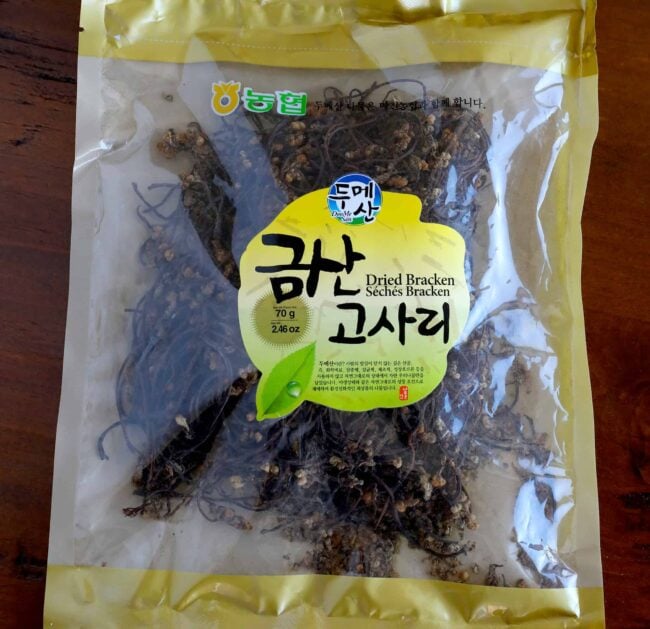
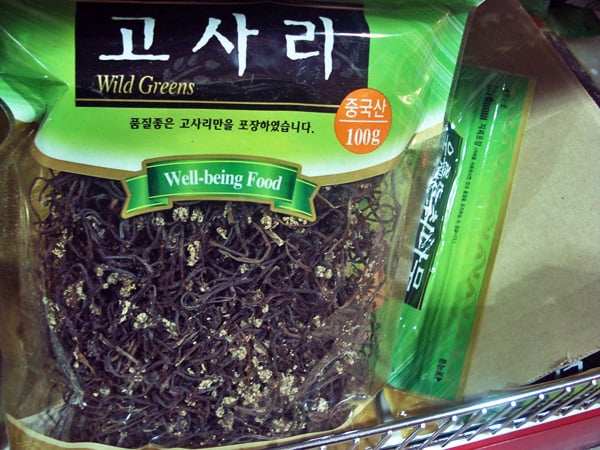
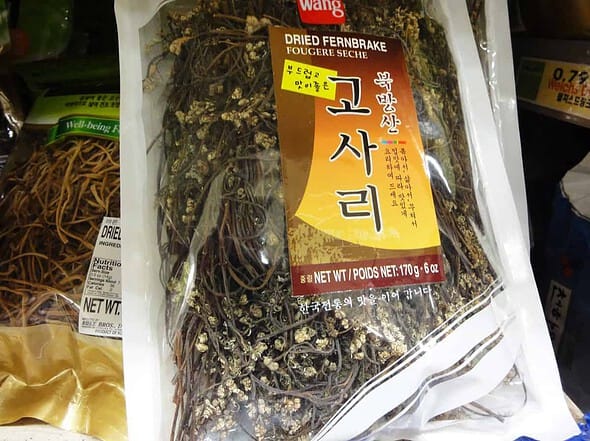
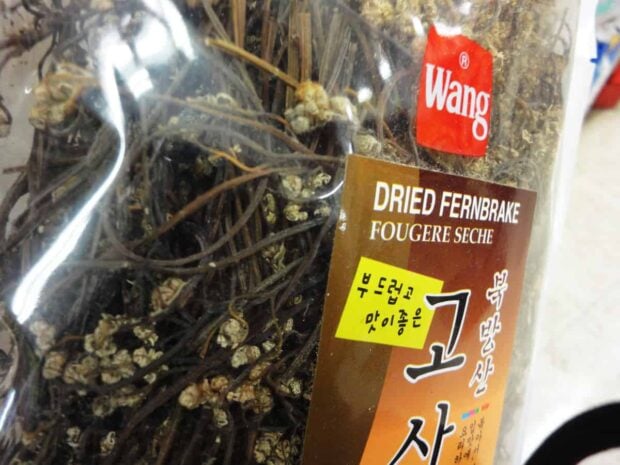
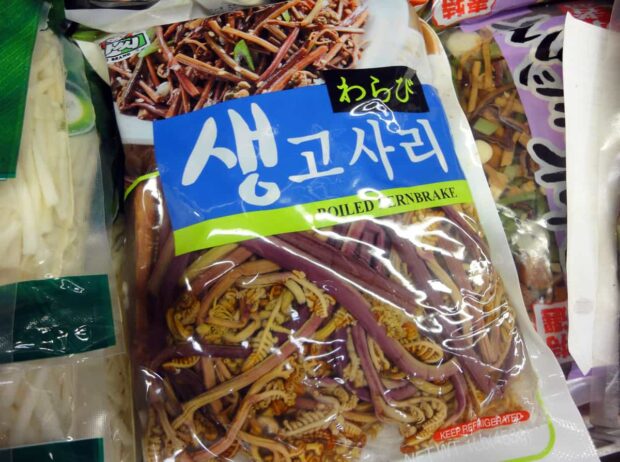
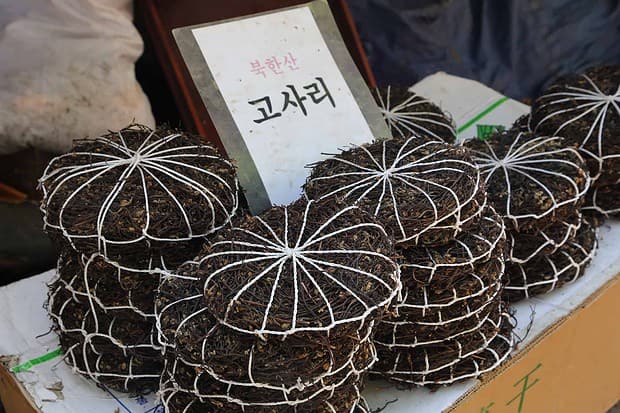





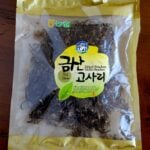



Hi!
I was wondering if you’ve ever had any leads on finding gosari in the UK?
This is one of my favourite dishes to make, especially this time of year, and I can’t seem to find it anywhere!
Thanks!
Be sure to check your local Korean grocery store first, they usually have it. There is a list of Korean stores in the UK here: https://www.maangchi.com/shopping/uk I hope that you can find one near you!
I did it ! Last night, I did it ! I am now ready to make some Yukgaejang tonight.
Me and my gosari are pretty excited : my first korean recipe.
And I wasn’t even aware before that fernbrake were something to eat…
Thanks Maangchi !
How much does 1 oz of dried gosari weigh after cooking?
I’m making your Yukgaejang which needs 6 oz of gosari. I’m wondering how much dried gosari I need — I’m guessing much less than 6 oz.
Dried gosari will expand 10 to 11 times in weight.
I totally miss going gosari picking! My family and I used to go all the time when I was a kid. We used to go around Big Bear, here in socali. We would climb up the mountains and bring huge bags to stuff all the gosari in. We even had gosari picking contests (with family friends) to see who can pick the most gosari. Fun times!
Not too long ago, I made gosari banchan. And it was the first time having gosari in a while…making that brought back childhood memories of going up to the mountains in our RV. http://www.behgopa.com/2014/02/gosari-namul-fernbrake-side-dish-and.html
To anyone who enjoys a good story…
I would recommend reading MissKim’s gosari picking story! It’s precious and it really brought back some good memories of my family going shellfishing many many years ago! In fact it inspired me to make my first post outside of Maangchi’s website. I give her 2 thumbs up for a very interesting and addictive blog! ^__^
Dave
Thank you for sharing the blog story! “We even had gosari picking contests” You will never forget what gosari looks like in the mountain. : )
I posted your gosarinamul photo on google plus Koreanfood group. https://plus.google.com/u/0/b/105178906808206746596/communities/105245991552998515026
Sorry I didn’t check this discussion before I tried to make some kosari with dried fernbracken I bought about a year ago.
It had very brief instructions in English which said to boil it for 20 minutes, drain, and then soak in cold water for an hour, then mix with sesame oil, soy sauce, shiitake muishroom powder, and red pepper and stir fry.
I had used just a small bit of it when I first bought it, then placed it in a ziploc bag.
I had no idea how much to use so I prepared the WHOLE BAG.
What a waste. It wasn’t softened properly and I had two HUGE bowls of it. (If I had used 20 cups of water for each cup of dried bracken I would have had to move out of my house to make room for it! :-)
Hello, Maangchi…
You’ve been my Teacher for about three years, but this is the first time I’ve written to ask you a question. Your instructions are so complete I’ve never had to ask one before- but this isn’t exactly about a recipe…
Here goes!
I’m trying to learn how to gather, process, and dry bracken for kosari… I live in Washington State and am gathering bracken for experimenting with. So far, I’ve soaked overnight (with soda), rinsed, boiled in fresh water, and put to dry about ten pounds but I have no idea if I’m doing it right.
Can you help with the old way that Korean people handled and dried the bracken after gathering? I’m hoping you might know about this from your Mother/ Grandmother, or if not, that you might know someone else who’s willing to share the knowledge!
There aren’t any instructions online- just a few casual references…For example, I read that in Korea the ferns were either soaked or boiled with wood ashes, but no mention of what kind, or when/why/how much to add.
I think this was done to remove bitterness/toxins-?
My questions are:
1) How much of the fresh stalk can be used?
2) Should I presoak them in cold water overnight before cooking? (With/without ashes/soda???)
3) What’s the story with the wood ashes?
4) Should I cut the stalks in half before soaking/cooking, or leave them whole?
5) How long should I boil them?Is it a matter of proper texture/feel?- should they be “squishy”???
6) I notice that dried kosari from the market is pretty thin…should I crush the thicker stalks while boiling so they’ll sort of splinter apart?
Any help you can give will be much appreciated.
Thanks, I hope!
Francesca
My mother and I would always use all of the fernbrake.
If they are already dried, we would just throw them in the pot of boiling water but you can also pre-soak them as you would with dried beans over night.
And back in traditional times, they would use wood ashes since this also gave a slow but steady temp to dry and preserve them. My mother and I would lay them out on newspapers in a storage room and keep the door closed w/a normal room fan turned on to dry them before storing them in big black trash bags to use when we needed.
You can either leave them whole or cut them up into bite size pieces. We actually would just leave them whole.
And don’t crush them so that they splinter. Leave them whole.
Enjoy the meal! :D
Check this out please. https://www.maangchi.com/talk/topic/question-on-kosari
hi do you know how to make kosari cause here in my place in Philippines korean store is very far..I wonder if i can make kosari out from native fern growing here on my place its called “paco” or “vegetable fern” we used to eat it fresh on salad or sautéed
http://en.wikipedia.org/wiki/Diplazium_esculentum
http://homecookingrocks.com/guinataang-paco-vegetable-fern-with-pork-and-coconut-cream/
Check out my bibimbap recipe. https://www.maangchi.com/recipe/bibimbap I use gosari in the recipe. You can sautee it by following the direction in the recipe.
“You can buy soaked and cooked “kosari” at a Korean grocery store. Prepare about 2 or 3 cups of kosari for this 4 servings of bibimbap. Cut it into pieces 5-7 cm long and sauté in a heated pan with 1 ts of vegetable oil. Stir and add 1 tbs of soy sauce, 1/2 tbs of sugar, and cook them for 1-2 minutes. Add sesame oil. “
Hi Maangchi,
I was wondering in the bibimbap can i use sweet potato sprout instead of fernbrake, I went to H-mart and they don’t carry fernbrake at all.